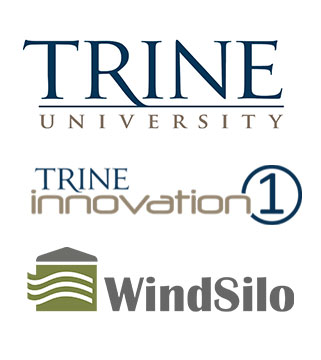WindSilo Turbines with
XYO Balancing Technology
Create a Proprietary
VAWT Design
Wind Turbines provide a clean energy source emitting no greenhouse gases and no waste products.
Our vertical axis wind turbine utilizes our proprietary XYO Technology, which substantially improves balancing issues that are common in wind turbines today. The WindSilo design is engineered to allow for much faster spin speeds and greater energy output.
This innovation in turbine design could eliminate expensive traditional balancing methods while increasing performance, reliability and efficiency.
Trine University, a strategic partner of Perpetual Industries, has been awarded a grant to develop the WindSilo
Through the IEDC’s Innovation Voucher program, Trine University’s ‘Innovation1’ department was awarded a grant to assist Perpetual Industries in the development of its proprietary vertical axis wind turbine, "The WindSilo".
Read more
WindSilo Advantages
- XYO TechnologyProprietary Automatic Mechanical Balancer inside
- Reduced NoiseSelf balancing turbines produce less noise emissions & greater power output
- Power OutputVAWT's can produce more power output than horizontal axis turbines.
- Vertical Axis TurbineOmni-directional design with ability to control spin speeds at all altitudes
- Environmentally FriendlyNot harmful to birds or bats and blends easily into the landscape.
- Requires Less SpaceCan be grouped close together, increasing the generated power/unit of land area
Market Potential
Wind is a clean, green non-polluting source of energy which offers a sustainable option for renewable energy.
2019 saw global new wind power installations surpassing 60 GW, a 19 per cent growth compared to 2018, and bringing total installed capacity to 650 GW, a growth of 10 per cent compared to last year.
New installations in the onshore wind market reached 54.2 GW, while the offshore wind market passed the milestone of 6 GW, making up of 10% of the global new installation in 2019 the highest level to now.
Wind energy has gone from a niche to a mainstream energy source in recent decades. For example, wind energy:
- Provided 15 per cent of the EU’s electricity demand in 2019
- Constitutes the third largest energy source in China
- Is known as the largest source of new power capacity in markets across the world.
Wind energy has expanded by leaps and bounds in the last 20 years. It began the century as a niche energy source in Europe and the US, and ended 2019 as a mainstream source of clean, cost-competitive energy around the world. In 2019, the global wind energy market reached a new milestone of 651 GW cumulative installed capacity, with strong continued growth foreseen across Asia, the Americas and Europe.
Wind power will play a leading role in achieving a low-carbon or – in many markets – net-zero future, one which requires a completely carbon-free energy sector and deep cuts in emissions in all other areas of the economy.
SOURCE - Global Wind Energy Council “GWEC” Global Wind Report 2019
Wind. Wind was the second largest renewable energy source (after hydropower) for power generation. Wind power produced more than 5 percent of global electricity in 2018 with 591 GW of global capacity (568.4 GW is onshore).
SOURCE: Center fo Climate and Energy Solutions “C2es”
Wind turbines kill an estimated 140,000 to 328,000 birds each year in North America.
Vertical Axis Wind Turbines (VAWT)
A vertical-axis wind turbines (VAWT) is a type of wind turbine where the main rotor shaft is set transverse to the wind (but not necessarily vertically) while the main components are located at the base of the turbine. This arrangement allows the generator and gearbox to be located close to the ground, facilitating service and repair.VAWTs do not need to be pointed into the wind, which removes the need for wind-sensing and orientation mechanisms.
VAWTs offer a number of advantages over traditional horizontal-axis wind turbines (HAWTs):
- Being omni-directional, some forms do not need to track the wind. This means they don't require a complex mechanism and motors to yaw the rotor and pitch the blades.
- VAWTs generally function better than HAWTs in turbulent and gusty winds. HAWTs cannot efficiently harvest such winds, which also cause accelerated fatigue.
- the gearbox of a VAWT takes much less fatigue than that of a HAWT.
- In VAWTs, gearbox replacement and maintenance are simpler and more efficient, as the gearbox is accessible at ground level, so that that no cranes or other large equipment are needed on-site. This reduces costs and impact on the environment. Motor and gearbox failures generally are significant considerations in the operation and maintenance of HAWTs both on and offshore.
- some designs of VAWTs in suitable situations can use screw pile foundations, which hugely reduces the road transport of concrete and the carbon cost of installation. Screw piles can be fully recycled at the end of their life.
- wings of the Darrieus type have a constant chord and so are easier to manufacture than the blades of a HAWT, which have a much more complex shape and structure.
- VAWTs can be grouped more closely in wind farms, increasing the generated power per unit of land area.
- VAWTs can be installed on HAWT wind farm below the existing HAWTs; this can supplement the power output of the existing farm.
- research at Caltech has also shown that a carefully designed wind farm using VAWTs can have an output power ten times that of a HAWT wind farm of the same size.

Incubator of Innovative, Energy Efficient,
& Environmentally Friendly Technologies

